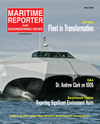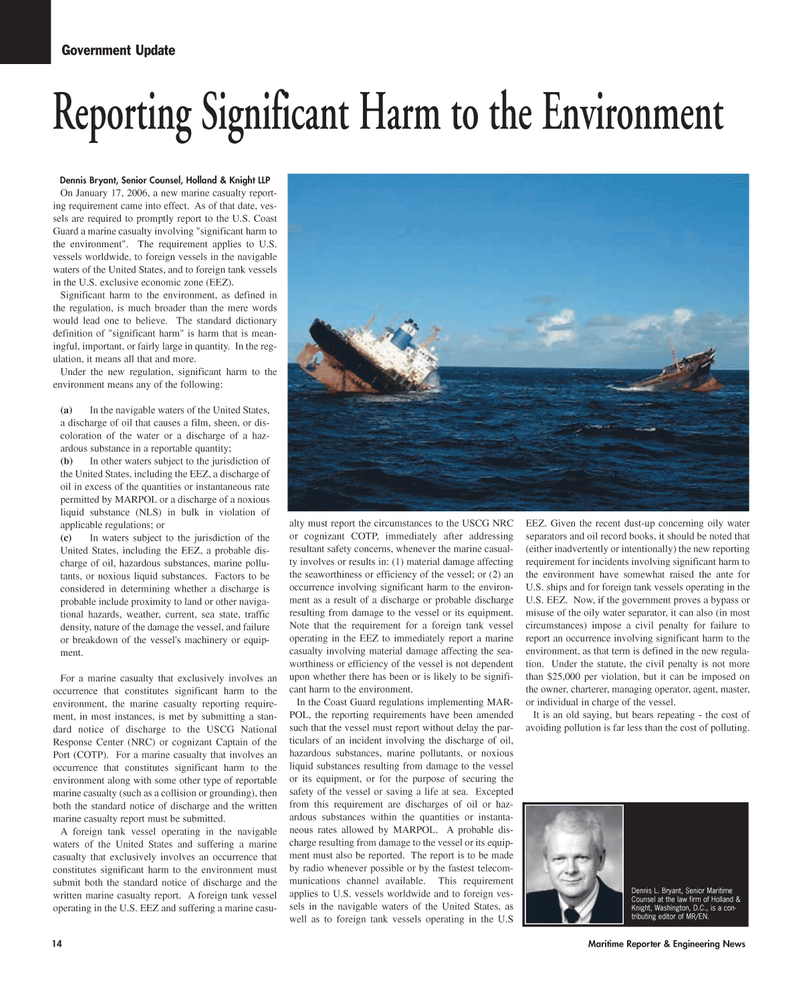
Page 14: of Maritime Reporter Magazine (March 2006)
The Training & Education Edition
Read this page in Pdf, Flash or Html5 edition of March 2006 Maritime Reporter Magazine
14 Maritime Reporter & Engineering News
Dennis Bryant, Senior Counsel, Holland & Knight LLP
On January 17, 2006, a new marine casualty report- ing requirement came into effect. As of that date, ves- sels are required to promptly report to the U.S. Coast
Guard a marine casualty involving "significant harm to the environment". The requirement applies to U.S. vessels worldwide, to foreign vessels in the navigable waters of the United States, and to foreign tank vessels in the U.S. exclusive economic zone (EEZ).
Significant harm to the environment, as defined in the regulation, is much broader than the mere words would lead one to believe. The standard dictionary definition of "significant harm" is harm that is mean- ingful, important, or fairly large in quantity. In the reg- ulation, it means all that and more.
Under the new regulation, significant harm to the environment means any of the following: (a) In the navigable waters of the United States, a discharge of oil that causes a film, sheen, or dis- coloration of the water or a discharge of a haz- ardous substance in a reportable quantity; (b) In other waters subject to the jurisdiction of the United States, including the EEZ, a discharge of oil in excess of the quantities or instantaneous rate permitted by MARPOL or a discharge of a noxious liquid substance (NLS) in bulk in violation of applicable regulations; or (c) In waters subject to the jurisdiction of the
United States, including the EEZ, a probable dis- charge of oil, hazardous substances, marine pollu- tants, or noxious liquid substances. Factors to be considered in determining whether a discharge is probable include proximity to land or other naviga- tional hazards, weather, current, sea state, traffic density, nature of the damage the vessel, and failure or breakdown of the vessel's machinery or equip- ment.
For a marine casualty that exclusively involves an occurrence that constitutes significant harm to the environment, the marine casualty reporting require- ment, in most instances, is met by submitting a stan- dard notice of discharge to the USCG National
Response Center (NRC) or cognizant Captain of the
Port (COTP). For a marine casualty that involves an occurrence that constitutes significant harm to the environment along with some other type of reportable marine casualty (such as a collision or grounding), then both the standard notice of discharge and the written marine casualty report must be submitted.
A foreign tank vessel operating in the navigable waters of the United States and suffering a marine casualty that exclusively involves an occurrence that constitutes significant harm to the environment must submit both the standard notice of discharge and the written marine casualty report. A foreign tank vessel operating in the U.S. EEZ and suffering a marine casu- alty must report the circumstances to the USCG NRC or cognizant COTP, immediately after addressing resultant safety concerns, whenever the marine casual- ty involves or results in: (1) material damage affecting the seaworthiness or efficiency of the vessel; or (2) an occurrence involving significant harm to the environ- ment as a result of a discharge or probable discharge resulting from damage to the vessel or its equipment.
Note that the requirement for a foreign tank vessel operating in the EEZ to immediately report a marine casualty involving material damage affecting the sea- worthiness or efficiency of the vessel is not dependent upon whether there has been or is likely to be signifi- cant harm to the environment.
In the Coast Guard regulations implementing MAR-
POL, the reporting requirements have been amended such that the vessel must report without delay the par- ticulars of an incident involving the discharge of oil, hazardous substances, marine pollutants, or noxious liquid substances resulting from damage to the vessel or its equipment, or for the purpose of securing the safety of the vessel or saving a life at sea. Excepted from this requirement are discharges of oil or haz- ardous substances within the quantities or instanta- neous rates allowed by MARPOL. A probable dis- charge resulting from damage to the vessel or its equip- ment must also be reported. The report is to be made by radio whenever possible or by the fastest telecom- munications channel available. This requirement applies to U.S. vessels worldwide and to foreign ves- sels in the navigable waters of the United States, as well as to foreign tank vessels operating in the U.S
EEZ. Given the recent dust-up concerning oily water separators and oil record books, it should be noted that (either inadvertently or intentionally) the new reporting requirement for incidents involving significant harm to the environment have somewhat raised the ante for
U.S. ships and for foreign tank vessels operating in the
U.S. EEZ. Now, if the government proves a bypass or misuse of the oily water separator, it can also (in most circumstances) impose a civil penalty for failure to report an occurrence involving significant harm to the environment, as that term is defined in the new regula- tion. Under the statute, the civil penalty is not more than $25,000 per violation, but it can be imposed on the owner, charterer, managing operator, agent, master, or individual in charge of the vessel.
It is an old saying, but bears repeating - the cost of avoiding pollution is far less than the cost of polluting.
Government Update
Reporting Significant Harm to the Environment
Dennis L. Bryant, Senior Maritime
Counsel at the law firm of Holland &
Knight, Washington, D.C., is a con- tributing editor of MR/EN.
MR MARCH2006 #2 (9-16).qxd 3/2/2006 11:28 AM Page 14

 13
13

 15
15
